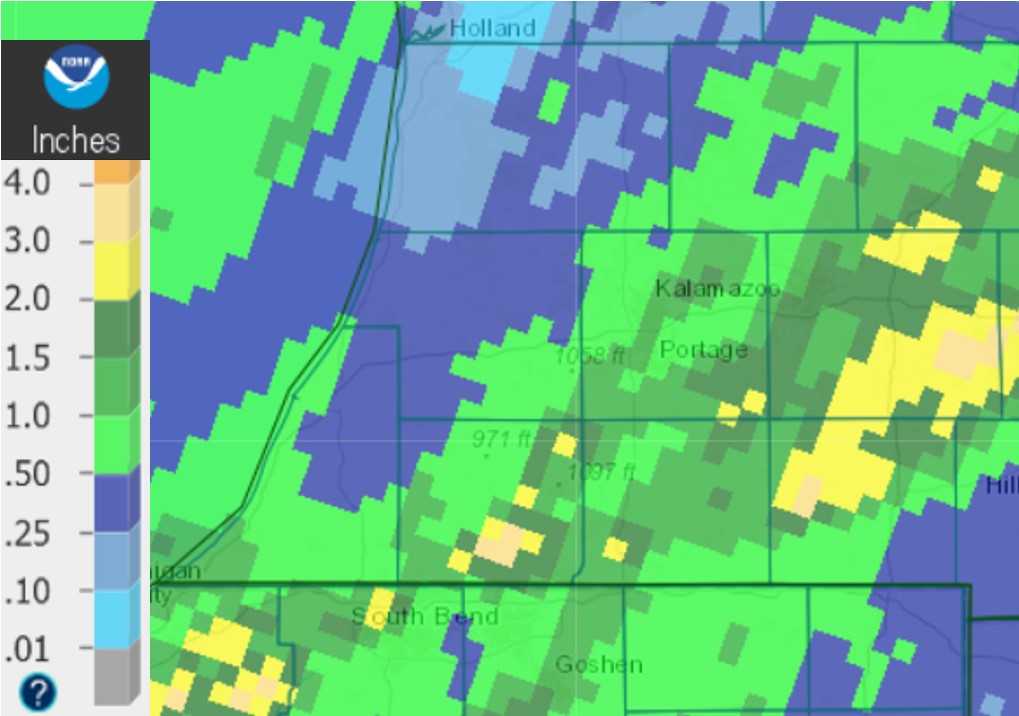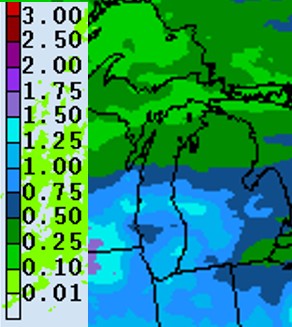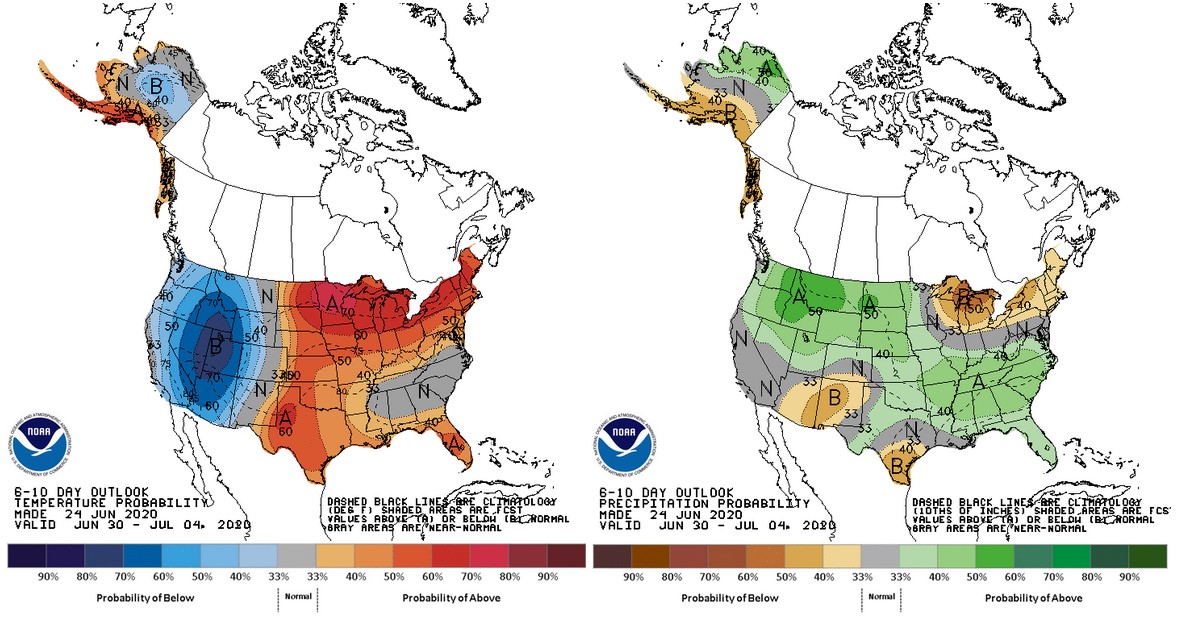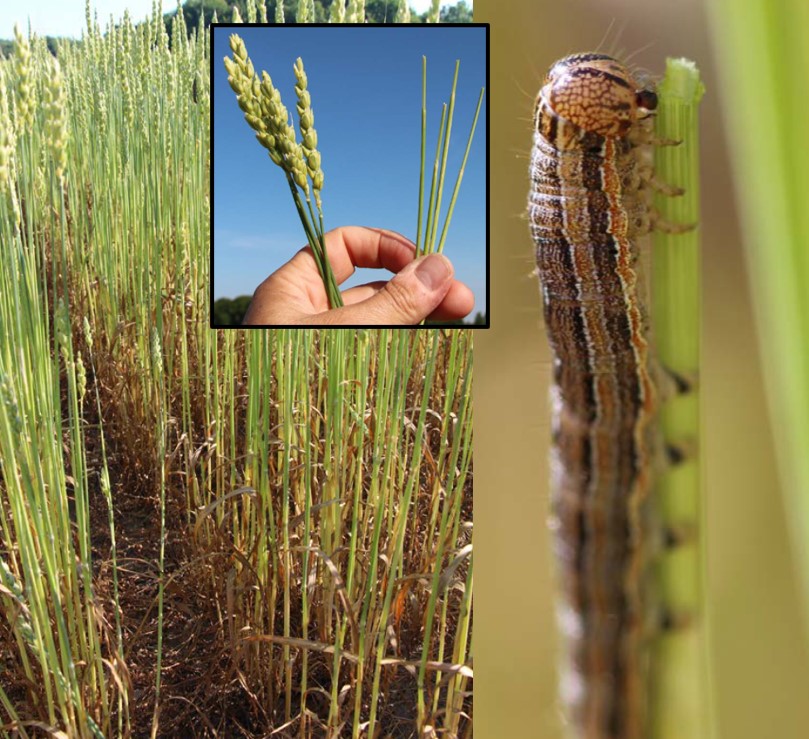Southwest Michigan field crop update – June 25, 2020
Cooler temperatures and ample rainfall this week will give way to hot and dry conditions for the rest of June, accelerating crop growth.

Weather
June has been warmer and drier than normal for most of southern Michigan. Aside from a few days this week, weekly potential evapotranspiration (PET) rates have been high due to warm and unusually windy conditions. The daily rates ranged from 0.20 to 0.25 inches, challenging to meet when the south central region only received 0.90 inches of rainfall during the first three weeks of June. That changed for many areas earlier this week with storm systems that approached out of the southwest, bringing local rainfall amounts as much as 3 inches in St. Joseph, Branch and Calhoun counties. The storm systems tracked southwest-to-northeast, which unfortunately left points further east with relatively little rainfall.
The forecast for the coming week calls for 0.75-1.25 inches of rain, mostly falling Friday through Saturday, with chances of higher amounts with local downbursts. The remainder of the month will be warmer than normal and dry due to the protection of a high-pressure system moving in over the weekend.
Lyndon Kelley, Michigan State University Extension and Purdue University irrigation educator, says that storm systems like the one that passed through Michigan earlier this week—where rainfall varied from 0.2 to 3.0 inches within a 2-mile span—accentuate the need to have at least one quality rain gauge in each field, especially if irrigation is used to supplement water needs. Look for his upcoming article, “A rain gauge in every irrigated field,” for details on how to build your own inexpensive rain gauge with a Taco Bell cup and a step-in electric fence post.
For fields that are located away from the home farm, Michigan State University Extension relays some advice from a farmer: giving a $20 McDonald’s gift card to a family who lives next to a remote field and asking them to text you rainfall amounts can save many hours and hundreds of miles in travel each year.




Corn
According to the USDA’s Crop Progress report, all the corn in the state is planted with 92% emerged. The crop was beginning to show signs of water stress prior to the rains this week, but 58% of corn in the state was still rated good or excellent with an additional 34% fair. We estimate that essentially all the corn in the south central is emerged with most fields between V4-V7. Sidedress applications and early postemergence herbicide applications are well underway.
Soybeans
According to the USDA’s Crop Progress report, soybean estimates for the state are exactly the same as for corn…what are the odds. Beans are between V2-V5, and although flowering can occur before the summer solstice, we have not seen any fields that have reached R1 yet. We have not received any reports of problems with the crop at this point.
For those who planted Xtend soybean this season, you likely have heard about the 9th Circuit Court of Appeals June 3 ruling on three EPA dicamba labels: XtendiMax, FeXipan and Engenia. There was much confusion and concern about what this would mean for farmers this year while the registrants appeal this ruling. EPA released information on June 8, stating: 1) any sale or distribution of these three products is now prohibited, and 2) farmers who have already purchased product can apply it through July 31. As the label restricts applications to no later than 45 days after planting, this date should accommodate all applications in soybean for the 2020 growing season.
Interestingly, since Tavium (dicamba plus S-metolachlor) was not included in the original lawsuit, its use has not been banned by the court’s ruling. For those who were not able to purchase one of the three disallowed dicamba products, ask your chemical dealer about the possibility of acquiring Tavium for any needed POST applications to control marestail, waterhemp and other challenging broadleaf weeds.
Wheat
Fields have completed pollination (Feeke’s 10.5.3) and have begun the ripening process. Fields should near harvest shortly after the July 4 weekend. If you missed the Wheat Virtual Field Day on June 10, recordings are now available on the Michigan Wheat website.
We have received reports of true armyworm infestations around the state in corn and wheat fields. Armyworm do not prefer soybean so they are not a pest in that crop. MSU Extension field crops educator Ricardo Costa, based in Lenawee County, and MSU Extension field crops entomologist Chris DiFonzo reported significant damage in corn and wheat fields in the southeast corner of the state last week. The farmer of the field in the photos below was considering chopping the field for forage, but after talking through several considerations with DiFonzo, including the preharvest interval for the available effective insecticides, the decision was made to make a pesticide application to protect yield and take it to harvest.
This damage was not readily seen from the road. Scout your fields! If you see armyworm larvae damage in your wheat or corn crop, contact your local Extension office for advice on the best management strategy. Check out this YouTube video about the true armyworm outbreak infestation.




 Print
Print Email
Email




